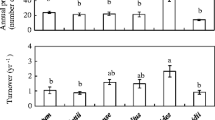Abstract
Some of the proximate factors that would induce aboveground stems to produce adventitious roots were investigated experimentally on Senecio cooperi, a tropical cloud forest tree. Stem segments were air-layered with different treatments to promote root formation, and the number of roots initiated and rates of root growth were monitored for 20 weeks. Treatments were the application of wet epiphytes or dry epiphytes plus associated humus, sponges wetted with either water or nutrient solutions, or dry sponges. Controls (stem segments with nothing applied) were also monitored. Numbers of adventitious roots formed and rates of subsequent root growth differed among treatments. Wet epiphyte/humus and nutrient solutions were most effective in producing roots, which suggests that epiphytes and the nutrients they intercept and retain within the canopy may cue adjacent host tissue to exploit this resource.
Similar content being viewed by others
References
Angeles G, Evert RF, Kozlowski TT (1986) Development of lenticels and adventitious roots in flooded Ulmus americana seedlings. Can J For Res 16:585–590
Coxson DS, McIntyre DD, Vogel HJ (1992) Pulsed release of sugars and polyols from canopy bryophytes in tropical montane rain forest (Guadeloupe, French West Indies). Biotropica 24:121–133
Davies FT Jr, Hartmann HT (1988) The physiological basis of adventitious root formation. Acta Hortic 227:113–120
Fink S (1983) The occurrence of adventitious and preventitious buds within the bark of some temperate and tropical trees. Am J Bot 70:532–542
Gill AM (1969) The ecology of an elfin forest in Puerto Rico, 6. Aerial roots. J Arnold Arbor 50:197–209
Gill AM, Tomlinson PB (1975) Aerial roots: an array of forms and functions. In: Torrey J, Clarkson D (eds) The development and function of roots. Academic Press, London, pp 238–258
Gill C (1975) The ecological significance of adventitious rooting as a response to flooding in woody species, with special reference to Alnus glutinosa (L.) Gaertn. Flora (Jena) 164:85–97
Ginzburg C (1967) Origin of the adventitious root apex in Tamarix aphylla. Am J Bot 54:4–8
Grier CC, Nadkarni NM (1987) The role of epiphytes in the nutrient cycles of two rain forest ecosystems. In: Lugo A, Ewel JJ, Hecht SB, Murphy PG, Padoch C, Schmink MC, Stone D (eds) People and the tropical forest: a research report from the U.S. Man and the Biosphere Program. US Department of State, Washington D.C., pp 28–30
Haissig BE (1974) Influences of auxins and auxin synergists on adventitious root primordium initiation and development. N Z J For Sci 4:311–323
Hartmann HT, Kester DE (1975) Plant propagation: principles and practices. 3rd edn. Prentice-Hall, Englewood
Herwitz S (1991) Aboveground adventitious roots and stemflow chemistry of Ceratopetalum virchowii in an Australian montane tropical rain forest. Biotropica 23:210–218
Jenik J (1973) Root systems of tropical trees. 8. Stilt-roots and allied adaptations. Preslia 45:250–264
Lanner R (1966) Adventitious roots of Eucalyptus robusta in Hawaii. Pac Sci 220:379–381
Lawton RO (1982) Wind stress and elfin stature in a montane forest tree: an adaptive explanation. Am J Bot 69:101–116
Lawton RO, Dryer V (1980) The vegetation of the Monteverde Cloud Forest Reserve. Brenesia 18:101–116
Moore PD (1989) Upwardly mobile roots. Nature 341:188
Nadkarni NM (1981) Canopy roots: convergent evolution in rainforest nutrient cycles. Science 213:1023–1024
Nadkarni NM (1983) The effects of epiphytes on nutrient cycles within temperature and tropical rainforest tree canopies. Ph.D. Thesis, University of Washington, Seattle
Nadkarni NM (1986) The effects of epiphytes on precipitation chemistry in a neotropical cloud forest. Selbyana 9:47–52
Nadkarni NM, Primack R (1989) A comparison of mineral uptake by above- and below-ground roots of Salix syringiana using gamma spectrometry. Plant Soil 113:39–45
Pereira JS, Kozlowski TT (1977) Variations among woody angiosperms in response to flooding. Physiol Plant 41:184–192
Sanford RL Jr (1987) Apogeotropic roots in an Amazon rain forest. Science 235:1062–1064
Sena Gomes AR, Kozlowski TT (1980) Growth responses and adaptations of Fraxinus pennsylvanica seedlings to flooding. Plant Physiol 66:267–271
Vance E, Nadkarni NM (1989) Microbial biomass and activity in canopy organic matter and the forest floor of a tropical cloud forest. Soil Biol Biochem 22:677–684
Author information
Authors and Affiliations
Rights and permissions
About this article
Cite this article
Nadkarni, N.M. Factors affecting the initiation and growth of aboveground adventitious roots in a tropical cloud forest tree: an experimental approach. Oecologia 100, 94–97 (1994). https://doi.org/10.1007/BF00317135
Received:
Accepted:
Issue Date:
DOI: https://doi.org/10.1007/BF00317135




